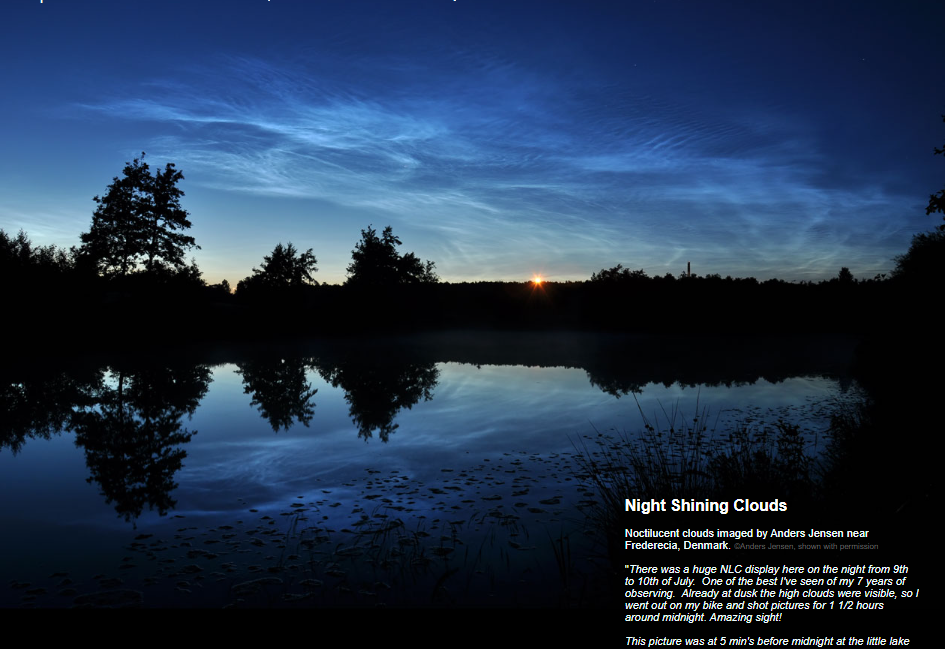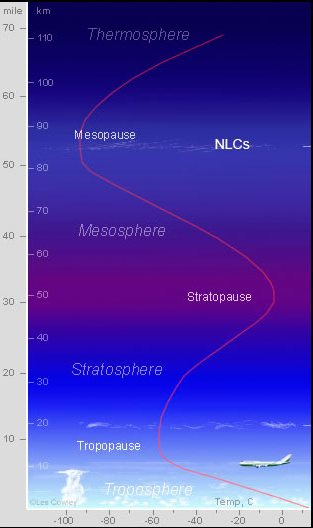OPOD - Noctilucent Clouds, Denmark
OPOD - Noctilucent Clouds, Denmark: A Mesospheric Marvel
Noctilucent clouds, also known as night shining clouds (NLCs), have become a captivating sight in the night sky, as witnessed by Anders Jensen near Frederecia, Denmark. This awe-inspiring display on the night of July 9th to 10th left Jensen astounded. He captured the momentous event, describing it as one of the most remarkable displays he has witnessed in his seven years of observing. As dusk approached, the high clouds became visible, prompting Jensen to venture out on his bike and photograph the celestial spectacle for about an hour and a half around midnight. The result was a mesmerizing image that showcased the ethereal beauty of Noctilucent clouds, with a distinct flame-like glow emanating from the burning waste gas of a nearby oil refinery.
Over the past few weeks, there has been an increase in the frequency of vibrant NLC displays. Some speculate that this phenomenon may be due to a combination of heightened sky observer activity and an actual rise in occurrences. While the exact cause remains uncertain, one thing is clear: Noctilucent clouds are becoming more numerous and appearing farther south with each passing year.
So, what exactly are Noctilucent clouds? These ethereal formations are Earth's highest clouds, forming at an astonishing altitude of 50-53 miles in the mesosphere. In this extreme environment, temperatures plummet to below -125 degrees Celsius, and the air pressure drops to a mere 1/1000th of that at sea level. These icy wonders consist of tiny ice crystals measuring approximately 0.1 micron in size. Their brilliance stems from their ability to scatter the sunlight that permeates the upper reaches of the atmosphere.
NLCs reside just a few miles below the mesopause, which marks the coldest layer of the atmosphere. In this realm, traditional temperature measurements lose their meaning, as the pressure is a mere 1 bar. The ordinary conductive and convective heat transfer that we are familiar with becomes negligible at these low pressures. Instead, molecular velocities and energies take center stage in characterizing the environment.
The increasing prevalence of Noctilucent clouds indicates a chilling and moistening of the summer mesosphere. It may seem paradoxical, but this change in temperature is attributed to tropospheric global warming. As our planet's lower atmosphere experiences warming trends, the mesosphere, situated above it, undergoes cooling. This intricate relationship between atmospheric layers highlights the interconnectedness of Earth's climate systems.
In conclusion, Noctilucent clouds continue to captivate sky observers with their otherworldly beauty. The recent surge in sightings suggests a rise in both observer activity and actual occurrences. These mesmerizing formations, composed of minuscule ice crystals, grace the highest reaches of Earth's atmosphere. As our planet experiences global warming, the summer mesosphere paradoxically cools and becomes moister, leading to an increase in Noctilucent cloud formations. So, the next time you find yourself gazing at the night sky, keep an eye out for these celestial marvels that add a touch of enchantment to our world above.

Night Shining Clouds
Noctilucent clouds imaged by Anders Jensen near Frederecia, Denmark. ©Anders Jensen, shown with permission
"There was a huge NLC display here on the night from 9th to 10th of July. One of the best I've seen of my 7 years of observing. Already at dusk the high clouds were visible, so I went out on my bike and shot pictures for 1 1/2 hours around midnight. Amazing sight!
This picture was at 5 min's before midnight at the little lake close to our place. The light in the middle is the flame from burning waste gas from the nearby oil refinery."
The last few weeks have seen many bright NLC displays. Each year they seem to get more numerous and appear further and further south. Is this real or only an effect of more and more sky observers sharing images? Probably both.
NLCs are Earth's highest clouds. They form 50-53 miles up in the intense cold (below -125 Celsius) and near vacuum of the mesosphere.
The are composed of small (0.1 micron) ice crystals and shine by scattering the high altitude sunlight.

NLCs are found a few miles below the mesopause, the coldest layer of the atmosphere.
At that level temperatures start to be a meaningless concept except for characterising molecular velocities and energies because the pressure is a mere 1 bar, 1/1000 of that at sea level. Ordinary conductive and convective heat transfer becomes insignificant to us at those pressures.
The increased occurrence of NLCs implies an increasingly colder and wetter summer mesosphere. Paradoxically, tropospheric global warming leads to lower mesosphere temperatures.
Note: this article has been automatically converted from the old site and may not appear as intended. You can find the original article here.
Reference Atmospheric Optics
If you use any of the definitions, information, or data presented on Atmospheric Optics, please copy the link or reference below to properly credit us as the reference source. Thank you!
-
<a href="https://atoptics.co.uk/blog/opod-noctilucent-clouds-denmark/">OPOD - Noctilucent Clouds, Denmark</a>
-
"OPOD - Noctilucent Clouds, Denmark". Atmospheric Optics. Accessed on November 23, 2024. https://atoptics.co.uk/blog/opod-noctilucent-clouds-denmark/.
-
"OPOD - Noctilucent Clouds, Denmark". Atmospheric Optics, https://atoptics.co.uk/blog/opod-noctilucent-clouds-denmark/. Accessed 23 November, 2024
-
OPOD - Noctilucent Clouds, Denmark. Atmospheric Optics. Retrieved from https://atoptics.co.uk/blog/opod-noctilucent-clouds-denmark/.